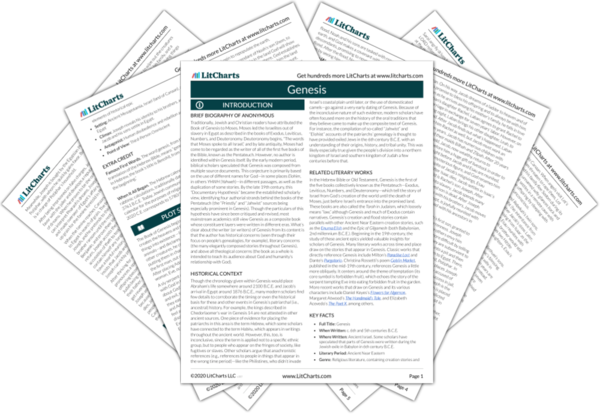God, Humanity, and Creation
The Book of Genesis is the first book of the Bible, the sacred text of Judaism and Christianity. Though traditional Jewish and Christian readers of this biblical book have attributed it to Moses (an early prophet and leader of the Jewish people), modern scholars believe that the book was written over a period of centuries—spanning from the 10th century B.C.E. to as recently as the 5th century B.C.E. Scholars also suggest that Genesis served to…
read analysis of God, Humanity, and CreationMistrust, Disobedience, and Death
In the early chapters of Genesis, humanity’s proliferation soon leads to trouble: people quickly disobey God, leading to widespread conflict, violence, and death. This disharmony suggests that human beings are meant to obey God in order to live in harmony with him and one another. This is because disobedience is rooted in mistrust of God—as especially shown by the story of Eve listening to a crafty serpent instead of obeying God. As a result…
read analysis of Mistrust, Disobedience, and DeathCovenants and Faith in God’s Promises
In the Bible, a covenant is an agreement between two parties (usually, God and humanity), which includes promises (usually by God) and conditions (things humanity must do—in general, obey God). Covenants were common in the ancient world, and the original hearers and readers of the biblical stories would have been familiar with them. In fact, they quickly become a central feature of the Book of Genesis, especially the covenants God makes with Noah and Abraham…
read analysis of Covenants and Faith in God’s Promises
The Role of Women
At the beginning of Genesis, women are portrayed as the pinnacle of God’s creation. After Adam finds no suitable partner among all God’s creatures, God undertakes a special operation (using part of Adam’s body) to create woman: “Then the man said, ‘This at last is bone of my bones and flesh of my flesh[.]’” Directly created by God, Eve’s position as “flesh of [Adam’s] flesh” suggests that she is not only made from…
read analysis of The Role of Women






